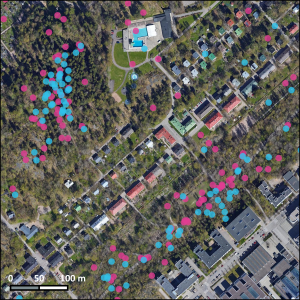Jussi Lampinen, PhD

Urban green spaces – hotspots of carbon storage, biodiversity and well-being benefits? Photograph © Oriol García Antúnez.
Urban green spaces are central to human well-being. Parks, playgrounds, remnant forests and grasslands are platforms of aesthetic, restorative and social experiences and provide the backdrop for many human-nature relationships in cities. However, it has long been recognized that green spaces also take part in the dynamics of carbon capture and storage in urban areas. Urban vegetation, whether planted or spontaneous, captures carbon dioxide from the air and, in time, either releases it back to the air or helps accumulate it to the soil. This capture and potential storage of carbon links urban green spaces to studies on mitigating the consequences of climate change in urban areas.
Indeed, much interest has already been given to, e.g. estimating the amount of carbon captured or “stored” in urban vegetation. On the contrary, the social acceptance and perceptions of carbon storage in urban green spaces have seldom been studied. Consequently, we do not know how urban residents perceive the role of their local green spaces in carbon capture, or how their attitudes vary towards managing green spaces for increased carbon capture. Likewise, we have only a limited understanding of how different residents perceive decisions aiming to increase the potential of carbon capture and storage in green spaces.
Without inclusive and just approaches to green space planning and design we run the risk of creating green spaces that are efficient in carbon capture but enjoy little support from local communities. The key to avoiding this and pinpointing sustainable, long-term policies for advancing the capture and storage of carbon in urban green spaces is understanding what makes green spaces efficient in carbon capture and storage and simultaneously respecting other needs and desires associated with green spaces. Equally important is to implement these policies in ways that respect the needs and desires of not only the majority of urban residents, but also minorities and those less represented in decision-making.
Quite the complex mess, right? Research at the CO-CARBON project, a Strategic Research Council (SRC)-funded consortium combining several universities and countries, aims to untangle this complex issue. The project revolves around the concept of carbon-smart green infrastructure, and Work Package 3 of the project focuses especially on the social understanding and acceptance of “carbon-smartness” as a feature of green infrastructure. Carbon-smartness here refers to features or qualities of green spaces that advance carbon capture and storage but also provide co-benefits to ecosystems and human wellbeing. Already this spring, surveys concerning the understanding and valuation of carbon-smartness are under way in Helsinki. For a peek at what is perceived as carbon-smart, have a look at the picture below:

Examples of green spaces perceived by residents to be personally important (pink) or carbon-smart (blue) in a city district in Helsinki, Finland. Aerial image © GoogleSatellite.
Pink dots represent green spaces local residents in a specific area in Helsinki consider as personally important, while blue dots represent those that the residents consider carbon-smart. There is still much to analyze, but one thing is already clear: carbon-smartness is something residents value in different ways, with both positive and negative connotations, and something that they are able to identify in their local neighborhoods. Personally, I cannot wait to dive into the survey responses properly – this is research at its most satisfying!
More information about the CO-CARBON project may be found here: https://cocarbon.fi/en/
More information regarding carbon capture and storage in urban green spaces, the environmental justice aspects of green space design may be found, e.g. in these articles:
- Ariluoma M et al. (2021) Carbon sequestration and storage potential of urban green in residential yards: A case study from Helsinki. Urban Forestry & Urban Greening 57: 126939
- Helsinki Region Environmental Services Authority (2021) Report on the carbon storages and sinks in the Helsinki Metropolitan Region. Final report. (Selvitys pääkaupunkiseudun hiilinieluista ja varastoista. Loppuraportti). https://julkaisu.hsy.fi/selvitys-paakaupunkiseudun-hiilinieluista-ja–varastoista.pdf
- Wolch JR et al. (2014) Urban green space, public health, and environmental justice: The challenge of making cities ‘just green enough’. Landscape and Urban Planning 125: 234-244.
- Strohbach MW & Haase D (2012) Above-ground carbon storage by urban trees in Leipzig, Germany: Analysis of patterns in a European city. Landscape and Urban Planning 104: 95-104.
About the author
Jussi defended his PhD-thesis in ecology at the University of Turku in 2020. His main research interests focus on seeking sustainable solutions to protecting biodiversity and mitigating climate-change within a social-ecological system -framework. Jussi joined the HNT research group in 2021. His current position as a post-doctoral researcher in the CO-CARBON -project concerns the perceptions and attitudes of urban residents towards climate-friendly urban green infrastructure and the fairness of decision-making concerning them. You can follow Jussi on Google Scholar.